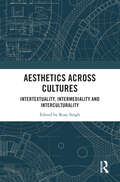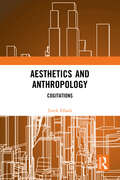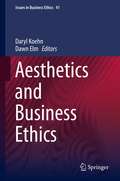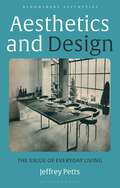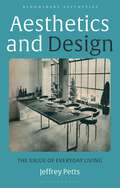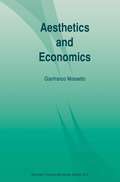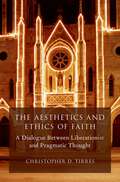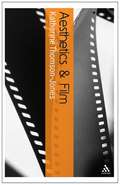- Table View
- List View
Aesthetics: A Reader in Philosophy of the Arts
by David Goldblatt Lee B. Brown Stephanie PatridgeAesthetics: A Reader in Philosophy of the Arts, fourth edition, contains a selection of ninety-six readings organized by individual art forms as well as a final section of readings in philosophical aesthetics that cover multiple art forms. Sections include topics that are familiar to students such as painting, photography and movies, architecture, music, literature, and performance, as well as contemporary subjects such as mass art, popular arts, the aesthetics of the everyday, and the natural environment. Essays are drawn from both the analytic and continental traditions, and multiple others that bridge this divide between these traditions. Throughout, readings are brief, accessible for undergraduates, and conceptually focused, allowing instructors many different syllabi possibilities using only this single volume. Key Additions to the Fourth Edition The fourth edition is expanded to include a total of ninety-six essays with nineteen new essays (nine of them written exclusively for this volume), updated organization into new sections, revised introductions to each section, an increased emphasis on contemporary topics, such as stand-up comedy, the architecture of museums, interactivity and video games, the ethics of sexiness, trans/gendered beauty, the aesthetics of junkyards and street art, pornography, and the inclusion of more diverse philosophical voices. Nevertheless, this edition does not neglect classic writers in the traditional aesthetics: Plato, Aristotle, Hume, Kant, Hegel, Heidegger, Collingwood, Bell, and writers of similar status in aesthetics. The philosophers writing new chapters exclusively for this fourth edition are: • Sondra Bacharach on street art • Aili Bresnahan on appreciating dance • Hina Jamelle on digital architecture • Jason Leddington on magic • Sheila Lintott on stand-up comedy • Yuriko Saito on everyday aesthetics • Larry Shiner on art spectacle museums in the twenty-first century • Peg Brand Weiser on how beauty matters • Edward Winters on the feeling of being at home in vernacular architecture, as in such urban places as bars.
Aesthetics: A Reader in Philosophy of the Arts
by David Goldblatt Lee B. Brown Stephanie PatridgeAesthetics: A Reader in Philosophy of the Arts, fourth edition, contains a selection of ninety-six readings organized by individual art forms as well as a final section of readings in philosophical aesthetics that cover multiple art forms. Sections include topics that are familiar to students such as painting, photography and movies, architecture, music, literature, and performance, as well as contemporary subjects such as mass art, popular arts, the aesthetics of the everyday, and the natural environment. Essays are drawn from both the analytic and continental traditions, and multiple others that bridge this divide between these traditions. Throughout, readings are brief, accessible for undergraduates, and conceptually focused, allowing instructors many different syllabi possibilities using only this single volume. Key Additions to the Fourth Edition The fourth edition is expanded to include a total of ninety-six essays with nineteen new essays (nine of them written exclusively for this volume), updated organization into new sections, revised introductions to each section, an increased emphasis on contemporary topics, such as stand-up comedy, the architecture of museums, interactivity and video games, the ethics of sexiness, trans/gendered beauty, the aesthetics of junkyards and street art, pornography, and the inclusion of more diverse philosophical voices. Nevertheless, this edition does not neglect classic writers in the traditional aesthetics: Plato, Aristotle, Hume, Kant, Hegel, Heidegger, Collingwood, Bell, and writers of similar status in aesthetics. The philosophers writing new chapters exclusively for this fourth edition are: • Sondra Bacharach on street art • Aili Bresnahan on appreciating dance • Hina Jamelle on digital architecture • Jason Leddington on magic • Sheila Lintott on stand-up comedy • Yuriko Saito on everyday aesthetics • Larry Shiner on art spectacle museums in the twenty-first century • Peg Brand Weiser on how beauty matters • Edward Winters on the feeling of being at home in vernacular architecture, as in such urban places as bars.
Aesthetics: A Reader in Philosophy of the Arts
by David Goldblatt Lee B. BrownAs with previous editions, the new Aesthetics: A Reader in Philosophy of the Arts uses classic and contemporary readings of leading philosophers of the arts. This Third Edition includes more than a dozen new essays either written or adapted especially for this volume. Containing more than 90 essays in total, the new edition offers generous choices for class readings, thus minimizing supplementary material needed for required assignments and independent research. In keeping with earlier editions, the Third Edition is a large collection of essays, most comparatively brief and organized first by groupings of art forms and then by general essays about the arts. It attempts to keep pace with theorizing about those art forms not traditionally covered in most books on aesthetics, like the jazz, rock, comics, video games, and even the aesthetics of junkyards. There is, then, an emphasis on the popular and mass arts and everyday aesthetics, as well as on time-honored problems in philosophy of the arts. This edition, which contains contributions by both analytic and continental philosophers, expands upon offerings in non-Western art and aesthetics. Finally, although intended to keep pace with topics and issues currently debated, instructors and students will find, in a special section, key classic texts.
Aesthetics: A Reader in Philosophy of the Arts
by David Goldblatt Lee B. BrownAs with previous editions, the new Aesthetics: A Reader in Philosophy of the Arts uses classic and contemporary readings of leading philosophers of the arts. This Third Edition includes more than a dozen new essays either written or adapted especially for this volume. Containing more than 90 essays in total, the new edition offers generous choices for class readings, thus minimizing supplementary material needed for required assignments and independent research. In keeping with earlier editions, the Third Edition is a large collection of essays, most comparatively brief and organized first by groupings of art forms and then by general essays about the arts. It attempts to keep pace with theorizing about those art forms not traditionally covered in most books on aesthetics, like the jazz, rock, comics, video games, and even the aesthetics of junkyards. There is, then, an emphasis on the popular and mass arts and everyday aesthetics, as well as on time-honored problems in philosophy of the arts. This edition, which contains contributions by both analytic and continental philosophers, expands upon offerings in non-Western art and aesthetics. Finally, although intended to keep pace with topics and issues currently debated, instructors and students will find, in a special section, key classic texts.
Aesthetics: Key Concepts in Philosophy (Key Concepts in Philosophy)
by Daniel HerwitzAesthetics is the branch of philosophical thought that arises from deep engagement with the arts. It is about larger issues such as meaning, identity, and medium that arise in the exploration of art, music, film and literature. Aesthetics: Key Concepts in Philosophy offers a thorough, lucid and stimulating account of the central theories and ideas encountered in aesthetics. The text is thematically structured, covering the discipline's principal concepts: taste, aesthetic judgment, aesthetic experience, and the definition of art. It includes an overview of the history of aesthetics and guides the reader through the work of all major philosophers who have engaged with aesthetics.
Aesthetics
by Dr Colin Lyas Colin LyasThis book presents an up-to-date introduction to the subject that captures the excitement and passion of art itself. It opens by exploring why art is important to us and goes on to grip the reader with a discussion of all of the areas central to aesthetics: aesthetic experience, representation, expression, definition of art, evaluation, interpretation, structuralism and post-structuralism, truth and morality. It draws upon the great thinkers on art, Plato and Kant, Croce and Beardsley, including the most recent iconoclastic views of Barthes and Derrida.
Aesthetics
by Dr Colin Lyas Colin LyasThis book presents an up-to-date introduction to the subject that captures the excitement and passion of art itself. It opens by exploring why art is important to us and goes on to grip the reader with a discussion of all of the areas central to aesthetics: aesthetic experience, representation, expression, definition of art, evaluation, interpretation, structuralism and post-structuralism, truth and morality. It draws upon the great thinkers on art, Plato and Kant, Croce and Beardsley, including the most recent iconoclastic views of Barthes and Derrida.
Aesthetics: 50 Puzzles, Paradoxes, and Thought Experiments (Puzzles, Paradoxes, and Thought Experiments in Philosophy)
by Michel-Antoine XhignesseAesthetics: 50 Puzzles, Paradoxes, and Thought Experiments is a teaching-focused resource, which highlights the contributions that imaginative scenarios—paradoxes, puzzles, and thought experiments alike—have made to the development of contemporary analytic aesthetics. The book is divided into sections pertaining to art-making, ontology, aesthetic judgements, appreciation and interpretation, and ethics and value, and offers an accessible summary of ten debates falling under each section. Each entry also features a detailed annotated bibliography, making it an ideal companion for courses surveying a broad collection of topics and readings in aesthetics. Key Features: Uses a problem-centered approach to aesthetics (rather than author- or theory-centered) making the text more inviting to first-time students of the subject Offers stand-alone chapters, allowing students to quickly understand an issue and giving instructors flexibility in assigning readings to match the themes of the course Provides up-to-date, annotated bibliographies at the end of each entry, amounting to an extensive review of the literature on contemporary analytic aesthetics
Aesthetics: 50 Puzzles, Paradoxes, and Thought Experiments (Puzzles, Paradoxes, and Thought Experiments in Philosophy)
by Michel-Antoine XhignesseAesthetics: 50 Puzzles, Paradoxes, and Thought Experiments is a teaching-focused resource, which highlights the contributions that imaginative scenarios—paradoxes, puzzles, and thought experiments alike—have made to the development of contemporary analytic aesthetics. The book is divided into sections pertaining to art-making, ontology, aesthetic judgements, appreciation and interpretation, and ethics and value, and offers an accessible summary of ten debates falling under each section. Each entry also features a detailed annotated bibliography, making it an ideal companion for courses surveying a broad collection of topics and readings in aesthetics. Key Features: Uses a problem-centered approach to aesthetics (rather than author- or theory-centered) making the text more inviting to first-time students of the subject Offers stand-alone chapters, allowing students to quickly understand an issue and giving instructors flexibility in assigning readings to match the themes of the course Provides up-to-date, annotated bibliographies at the end of each entry, amounting to an extensive review of the literature on contemporary analytic aesthetics
Aesthetics across Cultures: Intertextuality, Intermediality and Interculturality
by Rosy SinghThis book critically examines the "mutual illuminations" between literature, religion, architecture, films, performative arts, paintings, woodworks, memes and masks cutting across time and space. Architecture is a good example where the eventual success of a project depends on the harmony between physical sciences and aesthetics, design and planning, knowledge of building material, the local climate and awareness of cultural sensibilities. This volume affirms that aesthetics and arts are deeply linked through existential issues of who I am. The chapters in this volume present diverse discursive structures highlighting the in-between spaces between various art forms and mediums, such as: • Architecture, literature and memory • Kafka in SoHo; Kafka and Bernhard • Kirchner’s woodcuts; pictorial and stage representations of E.T.A. Hoffmann • Hesse’s fairy tales; translations of Pañcatantra • Nietzsche, ritual arts and face masks; martyrdom in La chanson de Roland • Goethe and Hafiz; Indian thought in Martin Buber • Rhythms of the "Third" across cultures • Dadaism and contemporary memes This book examines these sublime linkages in a comparative and interdisciplinary way. Engaging and intersectional, this volume will appeal to students and scholars of arts and aesthetics, literature, philosophy, architecture, sociology, translation studies and readers who are interested in cultural, intertextual, intermedial and comparative studies.
Aesthetics across Cultures: Intertextuality, Intermediality and Interculturality
This book critically examines the "mutual illuminations" between literature, religion, architecture, films, performative arts, paintings, woodworks, memes and masks cutting across time and space. Architecture is a good example where the eventual success of a project depends on the harmony between physical sciences and aesthetics, design and planning, knowledge of building material, the local climate and awareness of cultural sensibilities. This volume affirms that aesthetics and arts are deeply linked through existential issues of who I am. The chapters in this volume present diverse discursive structures highlighting the in-between spaces between various art forms and mediums, such as: • Architecture, literature and memory • Kafka in SoHo; Kafka and Bernhard • Kirchner’s woodcuts; pictorial and stage representations of E.T.A. Hoffmann • Hesse’s fairy tales; translations of Pañcatantra • Nietzsche, ritual arts and face masks; martyrdom in La chanson de Roland • Goethe and Hafiz; Indian thought in Martin Buber • Rhythms of the "Third" across cultures • Dadaism and contemporary memes This book examines these sublime linkages in a comparative and interdisciplinary way. Engaging and intersectional, this volume will appeal to students and scholars of arts and aesthetics, literature, philosophy, architecture, sociology, translation studies and readers who are interested in cultural, intertextual, intermedial and comparative studies.
Aesthetics and Anthropology: Cogitations
by Tarek ElhaikThis book focuses on the reconfiguration of aesthetic anthropology into an anthropological problem of cogitation, opening up a fascinating new dialogue between the domains of anthropology, philosophy, and art. Tarek Elhaik embarks on an inquiry composed of a series of cogitations based on fieldwork in an ecology of artistic and scientific practices: from conceptual art exhibitions to architectural environments; from photographic montages to the videotaping of spirit seances; from artistic interventions in natural history museums to ongoing dialogues between performance artists and marine scientists. The chapters examine the image-work, ethical demands, and aesthetic struggles of interlocutors including artists Mathias Goeritz, Mounir Fatmi, Silvia Gruner, Joan Jonas, and Patricia Lagarde.
Aesthetics and Anthropology: Cogitations
by Tarek ElhaikThis book focuses on the reconfiguration of aesthetic anthropology into an anthropological problem of cogitation, opening up a fascinating new dialogue between the domains of anthropology, philosophy, and art. Tarek Elhaik embarks on an inquiry composed of a series of cogitations based on fieldwork in an ecology of artistic and scientific practices: from conceptual art exhibitions to architectural environments; from photographic montages to the videotaping of spirit seances; from artistic interventions in natural history museums to ongoing dialogues between performance artists and marine scientists. The chapters examine the image-work, ethical demands, and aesthetic struggles of interlocutors including artists Mathias Goeritz, Mounir Fatmi, Silvia Gruner, Joan Jonas, and Patricia Lagarde.
Aesthetics and Art: Traditional and Contemporary China in a Comparative Perspective (China Academic Library)
by Jianping GaoThis book introduces traditional and modern aesthetics and arts, comparing the similarities and differences between traditional and modern Chinese aesthetics. It also explores the aesthetic implications of traditional Chinese paintings, and discusses the development of aesthetics throughout history, as well as the changes and improvements in Chinese aesthetics in the context of globalization.
Aesthetics and Business Ethics (Issues in Business Ethics #41)
by Daryl Koehn Dawn ElmLudwig Wittgenstein famously said, “Ethics is aesthetics.” It is unclear what such a claim might mean and whether it is true. This book explores contentious issues arising at the interface of ethics and aesthetics. The contributions reflect on the status of aesthetic en ethical judgments, the relation of aesthetic beauty and ethical goodness and art and character development. The book further considers the potential role art could play in ethical analysis and in the classroom and explores in what respects aesthetics and ethics might be intertwined and even mutually supportive.
Aesthetics and Design: The Value of Everyday Living (Bloomsbury Aesthetics)
by Jeffrey PettsWhat designers do and how we all, as users of designed things, live with their products raises fundamental philosophical questions about how we should live, and how the nature of design work and good design relates to our lives.Jeffrey Petts presents a holistic and pragmatist approach to the philosophy of design. Acknowledging the importance of function in design without downplaying the aesthetic dimension, Petts relates the manner of evaluating design to the designing process itself as demonstrated in the work of, for example, William Morris, Walter Gropius and Bauhaus, Charles and Ray Eames, and Dieter Rams. This metacritical and everyday approach to the philosophy of design expresses a commitment to real aesthetics, connecting concrete issues in both practice and experience to philosophical ideas, and reveals the role aesthetics plays in considerations about the good life.
Aesthetics and Design: The Value of Everyday Living (Bloomsbury Aesthetics)
by Jeffrey PettsWhat designers do and how we all, as users of designed things, live with their products raises fundamental philosophical questions about how we should live, and how the nature of design work and good design relates to our lives.Jeffrey Petts presents a holistic and pragmatist approach to the philosophy of design. Acknowledging the importance of function in design without downplaying the aesthetic dimension, Petts relates the manner of evaluating design to the designing process itself as demonstrated in the work of, for example, William Morris, Walter Gropius and Bauhaus, Charles and Ray Eames, and Dieter Rams. This metacritical and everyday approach to the philosophy of design expresses a commitment to real aesthetics, connecting concrete issues in both practice and experience to philosophical ideas, and reveals the role aesthetics plays in considerations about the good life.
Aesthetics and Economics
by Gianfranco MossettoAesthetics and Economics is a pioneering effort at treating aesthetics from the point of view of economic theory, and addresses the contradictions which have arisen from economists' work in this field over the years. Starting from an historical review of the treatment of aesthetics in economic thought, Aesthetics and Economics goes through the integration of a number of recent advances in economic thinking with the main topics of aesthetics, from creativity to interpretation. The subject is systematically treated on the grounds of a restatement of the optimization analysis on non-consequentialist bases, starting from the Kantian definition of aesthetic judgement up to its contemporary developments. A specific information asymmetry characterizing the agents' behaviours arises from the aesthetic qualification of consumption, production and investment processes, thus affecting the usual equilibrium and optimization conditions, resulting in new institutional interventions in the market. `Certification' of the aesthetic nature of goods and stocks is needed and gives place to original market strategies and optimization problems.
Aesthetics and Environment: Variations on a Theme
by Arnold BerleantThe essays collected in Aesthetics and Environment comprise a set of variations on art and culture guided by the theme of environment. The essays deal with the physical reality of environment such as the city, the shore, the water and the garden, but also with the virtual environment and the social one. Environmental aesthetics is a theme whose variations are as endless as the possibilities of the human performers and conditions from which it is fashioned. This enticing set of essays testifies to Berleant's special talent in moving easily between both natural and human environments and opens out the contemporary discussion beyond that of the wilderness to the cultural and social environment. Berleant argues that neither the natural nor human environment stands alone and both are best understood as distinctions that are in experience coextensive, that one can only speak of environment in relation to human experience. The theme of this book is that such experience suffuses the so-called natural world and shapes the human world. It maintains the idea that in as much as people are embedded in these worlds, relationships, including human relationships, are part of them. The melding of these two worlds leads Berleant to defend ultimately what he has termed 'social aesthetics' .
Aesthetics and Environment: Variations on a Theme
by Arnold BerleantThe essays collected in Aesthetics and Environment comprise a set of variations on art and culture guided by the theme of environment. The essays deal with the physical reality of environment such as the city, the shore, the water and the garden, but also with the virtual environment and the social one. Environmental aesthetics is a theme whose variations are as endless as the possibilities of the human performers and conditions from which it is fashioned. This enticing set of essays testifies to Berleant's special talent in moving easily between both natural and human environments and opens out the contemporary discussion beyond that of the wilderness to the cultural and social environment. Berleant argues that neither the natural nor human environment stands alone and both are best understood as distinctions that are in experience coextensive, that one can only speak of environment in relation to human experience. The theme of this book is that such experience suffuses the so-called natural world and shapes the human world. It maintains the idea that in as much as people are embedded in these worlds, relationships, including human relationships, are part of them. The melding of these two worlds leads Berleant to defend ultimately what he has termed 'social aesthetics' .
The Aesthetics and Ethics of Copying
by Darren Hudson Hick Reinold SchmückerThe Aesthetics and Ethics of Copying responds to the rapidly changing attitudes towards the use of another's ideas, styles, and artworks. With advances in technology making the copying of artworks and other artefacts exponentially easier, questions of copying no longer focus on the problems of forgery: they now expand into aesthetic and ethical legal concerns. This volume addresses the changes and provides the first philosophical foundation for an aesthetics and ethics of copying.Scholars from philosophy of art, philosophy of technology, philosophy of law, ethics, legal theory, media studies, art history, literary theory, and sociology discuss the role that copying plays in human culture, confronting the question of how-and why-copying fits into our broader system of values. Teasing out the factors and conceptual distinctions that must be accounted for in an ontology of copying, they set a groundwork for understanding the nature of copies and copying, showing how these interweave with ethical and legal concepts. Covering unique concerns for copying in the domain of artworks, from music and art to plays and literature, contributors look at work by artists including Heinrich von Kleist, Robert Rauschenberg, Courbet and Manet and conclude with the normative dimensions of copying in the twenty-first century.By bringing this topic into the philosophical domain and highlighting its philosophical relevance, The Aesthetics and Ethics of Copying establishes the complex conditions-ontological, aesthetic, ethical, cultural, and legal-that underlie and complicate the topic. The result is a timely collection that establishes the need for further discussion.
The Aesthetics and Ethics of Faith: A Dialogue Between Liberationist and Pragmatic Thought (AAR Reflection and Theory in the Study of Religion)
by Christopher D. TirresWhat is the future of liberation thought in the Americas? In this groundbreaking work, Christopher D. Tirres takes up this question by looking at the methodological connections between two quintessentially American traditions: liberation theology and pragmatism. He explains how pragmatism lends philosophical clarity and depth to some of liberation theology's core ideas and assumptions. Liberation theology in turn offers pragmatism a more nuanced and sympathetic approach to religious faith, especially its social and pedagogical dimensions. Ultimately, Tirres crafts a philosophical foundation that ensures the continued relevance of liberation thought in today's world. Keeping true to the method of pragmatism, the book begins inductively with a set of actual experiences-- the Good Friday liturgies at the San Fernando Cathedral in San Antonio, Texas-- and provides a compelling description of the way these performative rituals integrate the aesthetic and ethical dimensions of faith. Subsequent chapters probe this integration deductively at three levels of theoretical analysis: experience/metaphysics, sociality, and pedagogy. As Tirres shows, the aesthetic and ethical dimensions of faith emerge in different yet related ways at all three levels. He argues that utilizing the categories of the aesthetic and ethical enables a richer understanding of the dynamic relationship between faith and politics. This book builds new bridges between a number of discourses and key figures, and will be of interest to all who are interested in the liberatory potential of engaged faith praxis, especially when it is expressed in the form of religious ritual.
Aesthetics and Film (Bloomsbury Aesthetics)
by Katherine Thomson-JonesAesthetics and Film is a philosophical study of the art of film. Its motivation is the recent surge of interest among analytic philosophers in the philosophical implications of central issues in film theory and the application of general issues in aesthetics to the specific case of film. Of particular interest are questions concerning the distinctive representational capacities of film art, particularly in relation to realism and narration, the influence of the literary paradigm in understanding film authorship and interpretation, and our imaginative and affective engagement with film. For all of these questions, Katherine Thomson-Jones critically compares the most compelling answers, driving home key points with a wide range of film examples including Wiene's The Cabinet of Doctor Caligari, Eisenstein's October, Hitchcock's Rear Window, Kubrick's The Shining and Sluizer's The Vanishing. Students and scholars of aesthetics and cinema will find this an illuminating, accessible and highly enjoyable investigation into the nature and power of a technologically evolving art form.
Aesthetics and Film (Bloomsbury Aesthetics)
by Katherine Thomson-JonesAesthetics and Film is a philosophical study of the art of film. Its motivation is the recent surge of interest among analytic philosophers in the philosophical implications of central issues in film theory and the application of general issues in aesthetics to the specific case of film. Of particular interest are questions concerning the distinctive representational capacities of film art, particularly in relation to realism and narration, the influence of the literary paradigm in understanding film authorship and interpretation, and our imaginative and affective engagement with film. For all of these questions, Katherine Thomson-Jones critically compares the most compelling answers, driving home key points with a wide range of film examples including Wiene's The Cabinet of Doctor Caligari, Eisenstein's October, Hitchcock's Rear Window, Kubrick's The Shining and Sluizer's The Vanishing. Students and scholars of aesthetics and cinema will find this an illuminating, accessible and highly enjoyable investigation into the nature and power of a technologically evolving art form.






